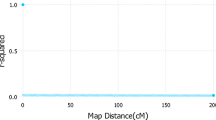Abstract
Two approaches for mapping quantitative trait loci (QTL) using linkage disequilibrium at the population level were investigated. In the trait-based (TB) approach, the frequencies of marker alleles (or genotypes) are compared in individuals selected from the two tails of the trait distribution. The TB approach uses phenotypic information only in the selection step. In the marker-based (MB) approach, the quantitative trait values for the marker genotypes in the selected individuals are compared. The MB approach uses both the difference in marker allele (or genotype) frequencies and the phenotypic values of each marker genotype in the selected samples. We quantify the power of each approach and show that the power of the MB approach is greater than or equal to that of the TB approach. The advantage of the former is expected to increase with increasing number of traits phenotyped. Our accurate predictions obviate the need for elaborate simulation studies.
Similar content being viewed by others
References
D.B. Allison M. Heo N. J. Schork S. L. Wong R. C. Elston (1998) ArticleTitleExtreme selection strategies in gene mapping studies of oligogenic quantitative traits do not always increase power Hum. Hered. 48 97–107
A. Angius E. Petretto G. B. Maestrale P. Forabosco G. Casu D. Piras M. Fanciulli M. Falchi P. M. Melis M. Palermo M. Pirastu (2002) ArticleTitleA new essential hypertension susceptibility locus on chromosome 2p24-p25, detected by genomewide search Am. J. Hum. Genet.. 71 893–905
J. S. Bader A. Bansal P. Sham (2001) ArticleTitleEfficient SNP-based tests of association for quantitative phenotypes using pooled DNA Genescreen. 1 143–150
M. G. Kendall A. Stuart (1961) The advanced theory of statistics. Vol. 2. Inference and relationship EditionNumber (4th ed.) Charles Griffin and Company Limited Great Britain
B. L. Langdahl M. Carstens L. Stenkjaer E. F. Eriksem (2003) ArticleTitlePolymorphisms in the transforming growth factor beta 1 gene and osteoporosis Bone 32 297–310
R. J. Lebowitz M. Soller J. S. Beckmann (1987) ArticleTitleTrait-based analyses for the detection of linkage between marker loci and quantitative trait loci in crosses between inbred lines Theor. Appl. Genet. 73 556–562
R. C. Lewontin (1964) ArticleTitleThe interaction of selection and linkage. I. General considerations; Heterotic Models Genetics 49 49–67
R. D. Little J. P. Carulli R. G. Del Mastro J. Dupuis M. Osborne C. Folz S. P. Manning P. M. Swain S. Zhao B. Eustace M. M. Lappe L. Spitzer S. Zweier K. Braunschweiger Y. Benchekroun X. Hu R. Adair L. Chee M. G. FitzGerald C. Tulig A. Caruso N. Tzellas A. Bawa B. Franklin S. McGuire X. Nogues G. Gong K. M. Allen A. Anisowicz A. J. Morales P. T. Lomedico S. M. Recker P. Van Eerdewegh R. R. Recker M. L. Johnson (2002) ArticleTitleA mutation in the LDL receptor-related protein 5 gene results in the autosomal dominant high-bone-mass trait Am. J. Hum. Genet. 70 11–19
M. Lynch B. Walsh (1998) Genetics and analysis of quantitative traits Sinauer Associates USA
N. J. Schork S. K. Nath D. Fallin A. Chakravarti (2000) ArticleTitleLinkage disequilibrium analysis of biallelic DNA markers, human quantitative trait lociand threshold-defined case and control subjects Am. J. Hum. Genet. 67 1208–1218
L. A. Sirota D. B. Greenberg D. L. Murphy D. H. Hamer (1999) ArticleTitleNon-linear association between the serotonin transporter promoter polymorphism and neuroticism:a caution against using extreme samples to identify quantitative trait loci Psychiatr. Genet. 9 35–38
Author information
Authors and Affiliations
Corresponding author
Rights and permissions
About this article
Cite this article
Tenesa, A., Visscher, P.M., Carothers, A.D. et al. Mapping Quantitative Trait Loci Using Linkage Disequilibrium: Marker- versus Trait-based Methods. Behav Genet 35, 219–228 (2005). https://doi.org/10.1007/s10519-004-0811-5
Received:
Accepted:
Issue Date:
DOI: https://doi.org/10.1007/s10519-004-0811-5




